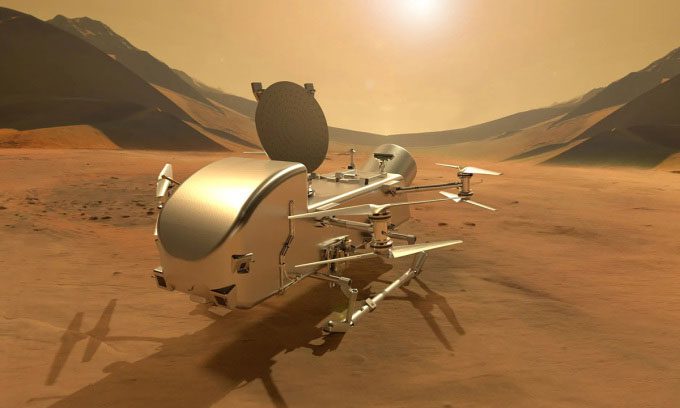The Dragonfly prototype, a large drone equivalent to a car, is set to launch toward Titan, the largest moon of Saturn. It has just completed wind tunnel testing.

Simulation of the Dragonfly drone. (Image: NASA/Johns Hopkins APL/Steve Gribben).
Following 63 successful flights exploring Mars, NASA’s Ingenuity helicopter has far exceeded its original mission objectives. NASA has gained valuable experience from this first aircraft and is applying it to a larger vehicle aimed at Titan, as reported by Interesting Engineering on October 24.
The Dragonfly drone is equipped with 8 rotors and is similar in size to a small car. Researchers at the Applied Physics Laboratory (APL) at Johns Hopkins University in Maryland conducted experiments with a prototype that is half the size of the final version and shared a video online.
Dragonfly will be NASA’s first mission targeting the surface of another “ocean world.” Similar to Earth, Titan has a weather system, rivers, lakes, and seas on its surface. However, unlike the blue planet, the flows on Titan contain liquid methane instead of water. Nonetheless, scientists believe that this moon may harbor extraterrestrial life.
The new drone will study Titan’s surface, where humans currently have very limited information. One advantage of this vehicle over Ingenuity is that Titan has a much denser atmosphere compared to Mars, meaning it will fly more easily. Titan also has lower gravity, making it less challenging to maintain a hovering state.
Experts testing the Dragonfly prototype. (Video: APL)
The recent tests were conducted in the wind tunnels at NASA’s Langley Research Center in Hampton, Virginia. The team tested Dragonfly in two different configurations to assess its landing process and transition to flight.
“We tested conditions within the expected flight range at various wind speeds, rotor speeds, and flight angles to evaluate the vehicle’s aerodynamic performance. We completed over 700 test runs, including more than 4,000 individual data points. All of our testing objectives were met, and the data will help increase the reliability of simulation models on Earth before extending to conditions on Titan,” said test team leader Bernadine Juliano.
Dragonfly is expected to launch into space in 2027. If plans proceed smoothly, it will reach Titan by 2034. Last year, NASA’s James Webb Space Telescope provided unprecedented detailed observations of this moon. When Dragonfly arrives, it could even change what we know about Titan and the evolution of the solar system.





















































